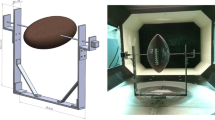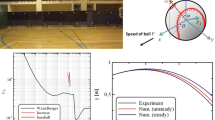Abstract
In this report, the aerodynamic characteristics, such as lift and drag, of an official rubber baseball are studied experimentally by comparing the characteristics of a sphere having a smooth surface and those of spheres having different surface structures. In addition, the flow velocity distribution is measured quantitatively using the spark tracing method. From the obtained results, the flow patterns for these baseballs and the flow mechanism around a sphere have been clarified.
Similar content being viewed by others
References
Mizota, T., Kuba, H. and Okajima, A., Erratic Behavior of Forkball, J. of Wind Engineering 62(1995), 3–21.
Bearman, P. W. and Harvey, J. K., Golf Ball Aerodynamics, Aeronautical Quarterly, 27(1976), 112–122.
Taneda, S., Negative Magnus Effect, Reports of Research Institute for Applied Mechanics, (1957).
Author information
Authors and Affiliations
Additional information
Katsumi Aoki: He received his M.Sc.(Eng.) and Ph.D. in mechanical engineering from Tokai University in 1967 and 1986. He received his degree in mechanical engineering and his from Tokai University. After obtaining his M.Sc. he worked as a research assistant, a lecturer, and an associate professor at Tokai University before taking up his current position as a professor of Tokai University. His current research interests cover flow around a rotating circular cylinder with and without grooves, flow around a rotating sphere, possibility of drag reduction using triangular cavities, and flow visualization of complicated flow fields, as in the centrifugal blower, by the spark tracing method.
Yasuhiro Kinoshita: He received his B. Eng. and M. Eng. Degree in mechanical engineering from Tokai University in 2000 and 2002. Since 2002, he is currentry an engineer at NORITAKE Co., LIMITED. His research interest is the aerodynamic characteristics of baseballs.
Jiro Nagase: He received his B.Ec. degree in Economics from Meiji University in 1957. His research interests are the flying characteristics of rubber balls used in baseball games and other sports balls. He is President of Nagase Kenko Co., which manufactures sporting goods in Japan. He is the Chairman of the Rubber Ball Industrial Club, Director of the International Exchange Association on rubber balls for junior baseball and Trustee of the World Children’s Baseball Foundation
Yasuki Nakayama: He received his B.Sc.(Eng) degree in Mechanical Engineering in 1952 and his Ph.D. in Mechanical Engineering in 1963 from Waseda University. He joined the National Railway Technical Research Institute and conducted several studies in the area of fluid mechanics. After leaving NRRI, as a Professor of Tokai University, he has been responsible for education and research on fluid mechanics and visualization. At present, he is serving concurrently as President of the Future Technology Research Institute. He has received a Medal with a Purple Ribbon from the Emperor of Japan, and many distinctions and awards for his outstanding research. He was a Visiting Professor of Southampton University, UK, President of The Visualization Society of Japan. He has published 10 books and more than 180 research papers.
Rights and permissions
About this article
Cite this article
Aoki, K., Kinoshita, Y., Nagase, J. et al. Dependence of aerodynamic characteristics and flow pattern on surface structure of a baseball. J Vis 6, 185–193 (2003). https://doi.org/10.1007/BF03181623
Received:
Revised:
Issue Date:
DOI: https://doi.org/10.1007/BF03181623




